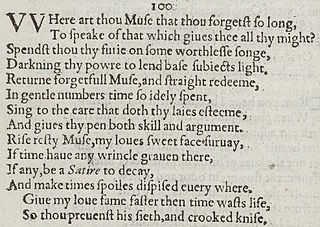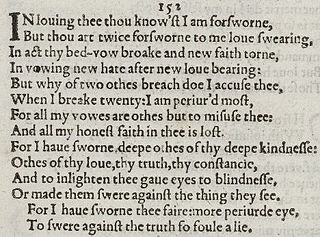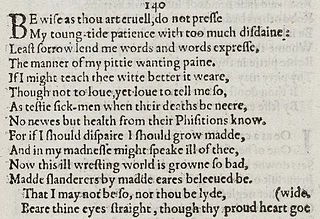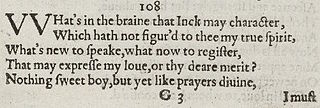| Sonnet 107 | |||||||
|---|---|---|---|---|---|---|---|
 Sonnet 107 in the 1609 Quarto | |||||||
| | |||||||
| |||||||
Sonnet 107 is one of 154 sonnets written by the English playwright and poet William Shakespeare. It is a member of the Fair Youth sequence, in which the poet expresses his love towards a young man.
| Sonnet 107 | |||||||
|---|---|---|---|---|---|---|---|
 Sonnet 107 in the 1609 Quarto | |||||||
| | |||||||
| |||||||
Sonnet 107 is one of 154 sonnets written by the English playwright and poet William Shakespeare. It is a member of the Fair Youth sequence, in which the poet expresses his love towards a young man.
This poem repeats the theme of others, notably sonnet 18, that the poem itself will survive human mortality, and both the poet and Fair Youth will achieve immortality through it. In this case all the hazards of an unpredictable future are added to the inevitability of mortality.
Sonnet 107 is an English or Shakespearean sonnet. The English sonnet has three quatrains, followed by a final rhyming couplet. It follows the typical rhyme scheme of the form ABAB CDCD EFEF GG and is composed in iambic pentameter, a type of poetic metre based on five pairs of metrically weak/strong syllabic positions. The 14th line exemplifies a regular iambic pentameter:
× / × / × / × / × / When tyrants' crests and tombs of brass are spent. (107.14)
Frequent variations make this sonnet metrically complex. The 2nd line begins with the rightward movement of the first ictus (resulting in a four-position figure, × × / /, sometimes referred to as a minor ionic), and follows with a mid-line reversal ("dreaming"), which places three ictuses in a row:
× × / / / × × / × / Of the wide world dreaming on things to come, (107.2)
Both of these metrical variations reappear in the poem: Mid-line reversals occur in lines 1 and 8, and an initial reversal occurs in line 9. Minor ionics occur in line 6 and potentially in lines 3 and 11.
In line 4, "confin'd" is "double-stressed in Shakespeare's English, and follow[s] the Alternating Stress Rule", moving its principal stress to the first syllable in the context of "confin'd doom". [2]
The line about the eclipse of the moon has sometimes been interpreted as reference to death of Queen Elizabeth I
Sonnet 107 can also be seen as referring to Doomsday. The sonneteer's love cannot even be ended by the "confined doom." The eclipse of the moon, then, like the "sad augurs," refers to a sign that might presage the Last Judgment. While everything else (the "tombs of brass" for example) comes to an end, the "poor rhyme" will be the last thing to go. As in Sonnet 55, the power of the sonnet to give life to the young man—or, here, to serve as a monument to him—will only be overshadowed when that young man literally comes forth from the grave on Judgment Day.

Sonnet 51 is one of 154 sonnets written by the English playwright and poet William Shakespeare. It is part of the Fair Youth sequence, in which the poet expresses his love towards a young man. It is a continuation of the argument from Sonnet 50.

Sonnet 100 is one of 154 sonnets written by the English playwright and poet William Shakespeare. It is a member of the Fair Youth sequence, in which the poet expresses his love towards a young man.

Sonnet 91 is one of 154 sonnets written by the English playwright and poet William Shakespeare. It's a member of the Fair Youth sequence, in which the poet expresses his love towards a young man.

Sonnet 134 is one of 154 sonnets written by the English poet and playwright William Shakespeare. In it, the speaker confronts the Dark Lady after learning that she has seduced the Fair Youth.

Sonnet 152 is a sonnet by William Shakespeare. It is one of a collection of 154 sonnets, dealing with themes such as the passage of time, love, beauty and mortality, first published in a 1609.

Sonnet 150 is one of 154 sonnets written by the English playwright and poet William Shakespeare. It is considered a Dark Lady sonnet, as are all from 127 to 152. Nonetheless 150 is an outlier, and in some ways appears to belong more to the Fair Youth.
Sonnet 149 is one of 154 sonnets written by the English playwright and poet William Shakespeare.

Sonnet 148 is one of 154 sonnets written by the English playwright and poet William Shakespeare.

Sonnet 142 is one of 154 sonnets written by the English playwright and poet William Shakespeare.

Sonnet 143 is one of 154 sonnets written by the English playwright and poet William Shakespeare.

Sonnet 140 is one of 154 sonnets written by the English playwright and poet William Shakespeare. Sonnet 140 is one of the Dark Lady sonnets, in which the poet writes to a mysterious woman who rivals the Fair Youth for the poet's affection.

Sonnet 139 is one of 154 sonnets written by the English playwright and poet William Shakespeare.
Sonnet 137 is one of 154 sonnets written by the English playwright and poet William Shakespeare.

Sonnet 119 is one of 154 sonnets written by the English playwright and poet William Shakespeare. It's a member of the Fair Youth sequence, in which the poet expresses his love towards a young man.

Sonnet 90 is one of 154 sonnets written by the English playwright and poet William Shakespeare. It is a member of the Fair Youth sequence, in which the poet expresses his love towards a young man.

Sonnet 95 is one of 154 sonnets written by the English playwright and poet William Shakespeare. It is a member of the Fair Youth sequence, in which the poet expresses his love towards a young man.

Sonnet 108 is one of 154 sonnets written by the English playwright and poet William Shakespeare. It is a member of the Fair Youth sequence, in which the poet expresses his love towards a young man.

Sonnet 114 is one of 154 sonnets written by the English playwright and poet William Shakespeare. It is a member of the Fair Youth sequence, in which the poet expresses his love towards a young man.

Shakespeare's sonnet 117 was first published in 1609. It uses similar imagery to Sonnet 116 and expands on the challenge in the closing couplet. Using legally resonant metaphors, the poet defends himself against accusations of ingratitude and infidelity by saying that he was merely testing the constancy of those same things in his friend.

Sonnet 122 is one of 154 sonnets written by the English playwright and poet William Shakespeare, and first published in 1609. It is a member of the Fair Youth sequence, in which the poet expresses his love towards a young man. Although the relationship started exuberantly in Sonnet 18 by now it has given way to an almost defensive tone. The poet justifies giving away or losing a notebook ("tables") given him by the youth to record shared events by saying that his memories of them are stronger.